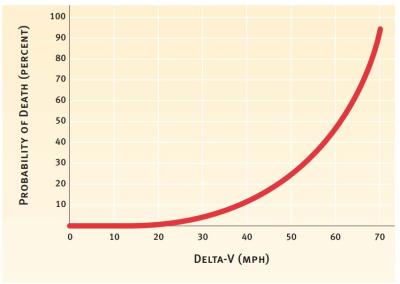
A speed limit is the maximum legal speed you can travel on a road under ideal conditions. You may drive slower than the speed limit, if you don’t impede the normal movement of traffic, but it is illegal to drive any faster. By law you must drive slower where signs indicate a school zone speed limit or work zone speed limit is in effect. Drive slower when conditions like road construction or bad weather make the posted speed unsafe.
If you are driving 20 or more miles per hour (mph) above the speed limit, or over 85 mph, a law enforcement officer can charge you with reckless driving, regardless of the speed limit.
Unless there is a speed limit sign stating otherwise, the maximum speed limit for passenger vehicles and motorcycles is 25 mph for school, business and residential areas; 35 mph for unpaved roads and 55 mph for all other roads. Some school zones may have automated photo enforcement, as indicated by “Speed Photo Enforced” signs or similar. The Virginia Department of Transportation explains how speed limits are set in this web page.
Safety First: Speeding increases the likelihood of crashes and reduces reaction time, putting not only the driver at risk but also passengers and pedestrians. Read more about the science of speed and crashes below.
Legal Consequences: Speeding tickets can result in fines, points on your license, increased insurance premiums and even license suspension in severe cases.
Environmental and Financial Impact: Higher speeds lead to increased fuel consumption and emissions, which can be bad for the environment – and your wallet.
Know the Limits: Familiarize yourself with speed limits in different areas and follow them strictly.
Plan Ahead: Leave early to avoid rushing and the temptation to speed.
Use Cruise Control: Use cruise control on highways to maintain a consistent speed and avoid unintentional acceleration.
Stay Focused: Minimize distractions, such as texting, eating or setting your GPS, while driving to maintain focus on the road.
Regular Maintenance: Ensure your vehicle is well - maintained, including brakes and tires, to optimize safety and performance.
Drive Defensively: Anticipate potential hazards and adjust your speed accordingly, especially in adverse weather conditions or on unfamiliar roads.
One undeniable fact demonstrates the importance of following speed limits: the faster you're driving, the more likely you are to be killed in a crash. Here's why:
Acceleration and Deceleration Forces: During a crash, the vehicle experiences rapid acceleration or deceleration, causing occupants to move forward or backward forcefully. Higher speeds result in greater forces, increasing the risk of injury.
Inertia: Newton's First Law states that an object in motion tends to stay in motion unless acted upon by an external force. In a crash, occupants continue moving at the vehicle's speed until stopped by a seat belt, air bag or other interior structure. The faster the vehicle is traveling, the greater the inertia. This leads to more severe injuries upon sudden deceleration.
Increased Impact Forces: As speed increases, so does the force of impact in a collision. The energy involved in a crash grows exponentially with speed. This means that even small increases in speed can dramatically impact the severity of injuries to occupants.
Reduced Reaction Time: Higher speeds reduce the time available for drivers to react to hazards on the road. A split-second delay in recognizing and responding to a potential danger can make the difference between a near miss and a catastrophic collision.
Decreased Control: Driving at high speeds reduces a driver's ability to maintain control of the vehicle, especially in adverse weather conditions or on winding roads. Loss of control at high speeds can lead to loss of vehicle stability, rollovers and more severe crashes.
Incompatibility with Crash Safety Systems: Modern vehicles are equipped with sophisticated safety features designed to protect occupants in the event of a crash. However, these systems are less effective at higher speeds, as the forces involved may exceed their protective capabilities.
Increased Risk of Ejection: High-speed crashes are more likely to result in ejection of vehicle occupants, significantly increasing the risk of serious or fatal injuries.
Impact on Pedestrians and Cyclists: Higher speeds also pose a greater risk to vulnerable road users such as pedestrians and cyclists. The likelihood of a pedestrian or cyclist being killed in a collision with a vehicle increases substantially as the speed of the vehicle increases.
By recognizing the lethal consequences of high-speed driving, drivers can make informed choices to prioritize safety on the road. Adhering to posted speed limits, adjusting speed for road and weather conditions and avoiding aggressive driving behaviors can all help reduce the risk of serious injury or death for everyone sharing the road. Remember, arriving safely is always more important than arriving quickly.
Think about the difference between jumping off a curb, a chair or the roof of a house. Physics explains the powerful relationship between vehicles speeds and the severity of crashes.

Notice on the graph above that an impact speed of 70 mph has a nearly 100% probability of death. That could be a driver hitting a tree at 70 mph, or it could be two drivers traveling at 35 mph and colliding head-on.
The relationship between speed and severity is not linear. The outcomes quickly become more dangerous for drivers and passengers. Even with seat belts, air bags and other safety features, here’s what happens as vehicle speed increases:
DMV thanks Andy Boenau of the City of Richmond for contributing information to this page.